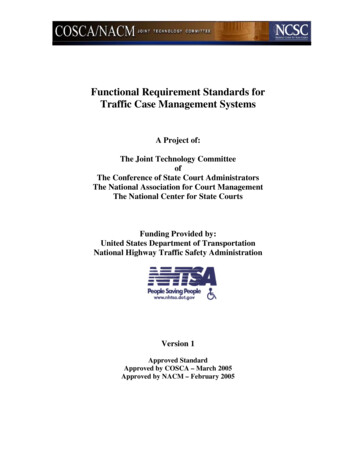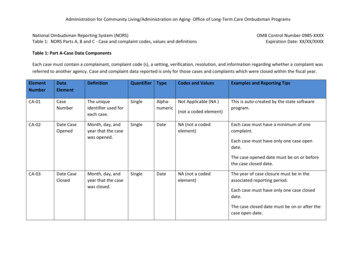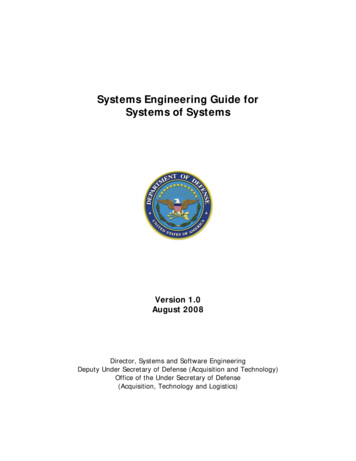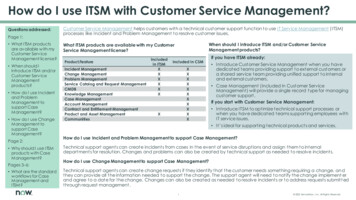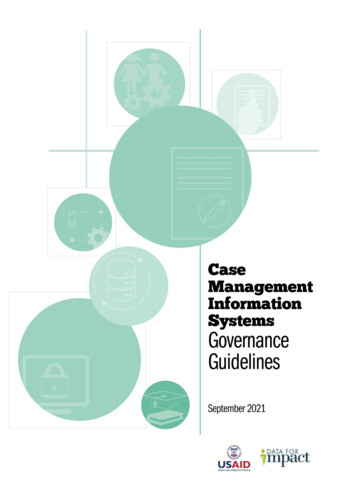
Transcription
MS-21-203 D4I2Case Management Information Systems
September 2021This publication was prepared by Rose Nzyoka, Joyce Nyaboga, Fredrick Onyango, and Molly Cannonfrom Palladium.Suggested citation: Nyaboga, J., Onyango, F., Nzyoka, R., and Cannon, M. (2021). Case ManagementInformation Systems Governance Guidelines. Washington, DC, USA: USAID and Data for Impact (D4I).Governance Guidelines3
AcknowledgmentsThe authors wish to acknowledge the efforts and contributions of numerous people who supporteddevelopment of the CMIS Governance Guidelines. We would like to thank the United States Agency forInternational Development (USAID) for entrusting us with this activity and providing the technical supportand financial resources that made it possible.We also thank members of the Data for Impact (D4I) Technical Working Group whose review andguidance provided a global perspective for the content of these guidelines and the Department of ChildrenServices of Kenya for their participation in piloting this tool and the maturity model toolkit. Finally, weacknowledge the D4I project’s leadership and staff who provided substantial support and input to thetoolkit and the USAID Tupime Kaunti project’s leadership and technical team for facilitating the pilot. Wethank the knowledge management team of the USAID-funded D4I project for editorial, design, andproduction services.4Case Management Information Systems
ContentsAcknowledgments . 4List of Figures . 6List of Tables . 6Introduction. 7Data for Impact . 8Background . 9Process of Developing the Guidance Document . 10Objectives. 10CMIS Governance Components . 10Strengthening CMIS Governance . 11Leadership and Coordination. 11Policy and Planning . 13Critical Steps in Strengthening CMIS Policy and Planning . 14Understand the Legal Environment . 14Strengthen the Policy Environment for CMIS . 14Develop and Implement a CMIS Change Management Protocol. 15Conduct Advocacy Activities . 15Resource Mobilization and Financing. 15Establish Accountability Mechanisms . 15Data . 16Adopt and Implement Data Governance Protocols . 16Develop a CMIS Data Quality Assurance Plan . 17ICT . 18Develop and Adopt ICT Governance Protocols . 18Adopt Best Practices in Systems Development and Implementation . 19Promote CMIS Interoperability . 20CMIS Governance Maturity Model. 23CMIS Governance Maturity Levels . 23The Maturity Model Toolkit . 24Glossary . 25References . 26Appendix 1. Sample CMIS Governance Strengthening Activities Roadmap . 27Appendix 2. Kenya CPMIS Responsibility Matrix Template. 28Appendix 3. Sample Data Use Template . 29Appendix 4. Sample Data Quality Assurance Plan . 30Appendix 5. Key Participants . 31Governance Guidelines5
List of FiguresFigure 1. CMIS governance components diagram . 10Figure 2. The Principles for Digital Development . 19Figure 3. Phases of the SDLC . 20Figure 4. Sample CMIS interoperability framework . 21Figure 5. CMIS governance maturity levels . 23List of TablesTable 1. Coordination mechanisms for CMIS implementation . 13Table 2. Description of CMIS policies . 15Table 3. Recommended CMIS data guidelines . 17Table 4. Dimensions for data quality assurance . 18Table 5. CMIS governance maturity level characteristics . 236Case Management Information Systems
IntroductionMany countries are implementing Case Management Information Systems (CMIS) as part of a global effortto enhance child protection interventions and case management services. CMIS is a digital tool used bymembers of the social service workforce to facilitate case management through the capture, storage, andprocessing of longitudinal data for effective tracking of social protection services provided to children. Thisinformation is used to enhance case management and promote impactful decision-making practices.CMIS are designed with a wide range of functionalities to support the core steps in the case managementprocess. These include registration of child profiles, performing initial and complex assessments, schedulingtasks for the different stakeholders involved in a case, displaying alerts and notifications for each case,establishing the status of the case, performing referrals to specialized services, making information availableto collaborating agencies or organizations, performing transfers of the case to other case managers, definingand recording actions of individual assistance plans, registering incidents, registering case closureinformation, etc. The system produces data that can be used to generate longitudinal indicators anddashboards that show information related to case management. At the same time, district and national levelauthorities can have access to the aggregated data generated by the CMIS to plan childcare initiatives.A good governance approach plays a critical role in ensuring that CMIS development, implementation, anduse strategies are aligned with national child protection and care policies, and that the CMIS delivers thefunctionality and services in-line with the current and planned needs of the government. Strong and maturegovernance practices ensures successful implementation of the CMIS at a national or sub-national level forimpactful interventions in child protection. Despite an increase in CMIS implementations globally, the lackof a standardized approach, driven by an overarching governance framework, has hampered the adoptionand successful implementation of CMIS due to the lack of ownership, accountability, and planning forsustainability.Governance Guidelines7
Data for ImpactThe United States Agency for International Development (USAID) works in countries around the world toimprove the lives of the most vulnerable children in keeping with the objectives established in the U.S.Government (USG) strategy for Advancing Protection and Care for Children in Adversity (APCCA). Insupport of country priorities and in line with APCCA objectives, USAID-funded activities advance partnercountries on their journey to self-reliance (https://www.usaid.gov/selfreliance) by helping governmentsbuild and strengthen their capacities to support, manage, and finance their child protection and care systems,using the best available data for decision making and employing research, implementation science, andprogrammatic learning to design evidence-based and evidence-informed policies, programs, and practices.The USAID-funded Data for Impact (D4I) project builds on and reinforces current USG support for prioritycountries to realize the power of data as actionable evidence that can improve policies, programs, andoutcomes (https://www.data4impactproject.org).Under the MEASURE Evaluation Phase IV activity,USAID developed the Information Systems Framework for the Case Management of Child Protection andCare (hereafter, referred to as the “CMIS framework”) to consolidate lessons learned from those who havedeveloped, implemented, and used such systems and agreed-upon best practices when approaching thedesign and strengthening of such systems. The framework presents three perspectives and related processesthat should be considered together to ensure a holistic approach to CMIS development. Though some of theprocesses have standardized tools and/or resources for child protection/care, for many processes, standardsdo not exist.This toolkit builds upon the lessons learned through the CMIS framework. Also, D4I reviewed tools such asthe mHealth Assessment and Planning for Scale (MAPS) toolkit and other frameworks used duringMEASURE Evaluation Phase IV CMIS assessments.The toolkit is the product of a participatory design process, through which a technical working groupvalidated the tools. The group involved 14 women and 15 men from country governments, USAID countrymissions, the Office of HIV/AIDS, UNICEF headquarters and field offices, case management experts,monitoring and evaluation (M&E) experts, and digital solution experts. The group included membersrepresenting Armenia, Colombia, Ghana, Guatemala, Kenya, Moldova, Rwanda, Uganda, and theUnited States.8Case Management Information Systems
BackgroundIncreased demand for timely and accurate child protection data by decision makers and social workers hascreated an urgency and a great opportunity to build impactful CMIS implementation. The sensitive anddynamic nature of child protection activities has necessitated the need to not only automate service deliverybut also to build strong systems that comply to technological and ethical standards while promotinginnovation and best practices. Successful implementation not only requires the highest safety and securitystandards, government ownership, and well-defined accountability mechanisms, but it also underlines theneed for a strong policy and regulatory base. Countries are at different levels with implementation of CMIS,and these systems are evolving from paper-based generation, transmission, and storage to web-basedsystems. A concerted effort is necessary to safeguard the gains by strengthening governance for theseinformation systems.D4I is supporting the development of a global governance guidance document for implementation andoversight of CMIS. This guidance document is part of the larger governance activity by D4I in developmentof a CMIS Assessment and Planning Toolkit designed to improve the capacity of governments inevaluating digital systems to support child protection and care and to assess their potential for scale-up andlong-term sustainability.This guidance document has taken into consideration some of the critical governance gaps that have beenhighlighted from assessments of information management systems for case management, such as theMEASURE Evaluation assessment of the Children First Software in Uganda (March 2019) and anassessment report of prerequisites for a social welfare information management system in Ghana1 (March2020). A major barrier for CMIS sustainability, documented in recent assessments, is the ultimategovernment leadership and ownership for CMIS system implementation and the establishment ofaccountability mechanisms to ensure that the right decisions are made, through the right consultativeprocesses, by the right stakeholders. This guide, therefore, consolidates governance components that informthe design, implementation, oversight and strengthening of such systems. It is written from a multisectoralperspective of CMIS implementation for the need to converge in a common governance approach. Itdesignates responsibilities and decision-making in a way that ensures that the most appropriate partiescontribute and that roles and responsibilities of each substructure within the governance structures aredefined. Implementation and oversight of CMIS is led by the country-specific government agency withresponsibility for children—but a CMIS that is longitudinal in nature also has information relevant todifferent ministries and may need to interoperate with those. Data sharing is critical as there are othersectors involved in case management for children, such as security, education, judiciary, and health, andthis will vary depending on country-specific context.Establishment of a governance structure for the implementation of the longitudinal information systemseeks to ensure that the decisions required for CMIS operation are made in a timely manner and are alignedwith the country's priorities under a governance framework. This guidance document elaborates on themechanisms used to endorse institutional decisions related to information systems, identify the officialswho are assigned the responsibility of endorsing these decisions, hold officials accountable for the results ofthese decisions, and identify the organizations (or departments) that must meet to discuss these rces/publications/tr-20-396.htmlGovernance Guidelines9
Process of Developing the Guidance DocumentThe CMIS Governance Guidelines have been developed through a wide stakeholder consultative process,led by a global CMIS Technical Working Group (TWG). This group included representatives fromgovernments, development partners, implementing partners, and academia. For a full list of the memberswho participated in the TWG refer to Appendix 5.The CMIS Governance Guidelines and the maturity model toolkit were piloted in Kenya by theDepartment of Children Services between May and August 2021. The results of the pilot confirmedapplicability in the local context and feedback was incorporated into the final document.ObjectivesThis CMIS Governance Guidelines have been developed to: Define a governance framework for large-scale CMIS Implementation. Provide operational guidance for use by countries in strengthening CMIS governance. Outline the structures and processes representing the norms, values, and rules for CMISgovernance. Highlight actionable steps towards achieving higher maturity levels in CMIS governance. Provide a CMIS Governance Maturity Model to help countries in assessing and determining thedegree of maturity of their CMIS governance processes.CMIS Governance ComponentsThe CMIS governance components are a set of interrelated domains and elements that represent a matureCMIS governance ecosystem.The CMIS governance components diagram in Figure 1 provides a contextual view of the CMISgovernance components and delineates a sequential and iterative approach towards strengtheninggovernance for successful implementation of the CMIS at a large scale.Figure 1. CMIS governance components diagramCountry-specific childprotection policiesRelevant government agencyNational Child Protection TWGSub-National Child nningICTDataICT governance protocolsHIS/ICT policiesData protection policy/actData Governance SOPsICT best practicesData Quality Assurance PlanCMIS interoperability guidelinesData management SOPs10Case Management Information Systems
Strengthening CMIS GovernanceThe prescribed steps for strengthening CMIS governance are aligned to the four domains identified inFigure 1; Leadership and Coordination, Policy and Planning, Data, and ICT, and the guidance presents asequential approach to CMIS governance strengthening activities that has been further illustrated in thesample CMIS Governance and Implementation Roadmap in Appendix 1.Although the steps illustrated are designed for countries that plan to start implementing the CMIS, thosecountries already implementing CMIS should utilize the CMIS Maturity Model at the onset to determinetheir baseline maturity level and identify any existing governance gaps. The gaps identified should informthe necessary steps to be taken in further strengthening the current governance approach.Leadership and CoordinationIn these guidelines, leadership refers to the decision makers responsible for developing, deploying, andproviding oversight of the adopted CMIS strategies. The leadership operates within defined organizationalstructures that facilitate a hierarchical arrangement of lines of authority, communications, rights, and duties.All activities towards strengthening CMIS governance should be led by the country-specific governmentagency in charge of child protection and care, through a collaborative process with relevant stakeholderswithin and outside of government. CMIS development and implementation requires coordinated effortsamong the actors and structures with a shared responsibility between the national and subnational levels. Adefined approach towards coordination of CMIS stakeholders should not only improve efficiency andaccountability but also ownership by the government. Effective coordination will reduce or eliminateduplication of investments.Key leadership roles include: Defining policy and guidelines for CMIS Providing the vision statement to describe the purpose, values, and aspirations for its casemanagement information systems Defining user regulations Ensuring use of the data from CMIS to inform decision making, planning, and programmanagement actions Providing oversight for CMIS implementation through policy compliance tracking Coordinating evaluation and periodic review of the CMIS Maintaining the centralized CMIS database Ensuring sufficient resources are available for implementation of CMIS, including human,technical, and financialThe department of ICT or equivalent government entity is critical in the development and maintenance ofCMIS and will be responsible for providing guidance on ICT regulations of data protection, data sharing,cyber security and storage of data, interoperability of systems, and interagency data sharing.The critical steps in strengthening the CMIS leadership and coordination are to:Determine the baseline level of CMIS governance maturity.The CMIS governance maturity refers to the level of experience that a country has achieved with referenceto the CMIS governance components described in this guidance document. The CMIS Maturity Model hasbeen provided later in this guidance document (see Table 5), as a tool to help countries determine theirGovernance Guidelines11
maturity levels and strengths, as well as their gaps, to inform priority interventions to improve theirperformance within the metrics described. A separate and customizable toolkit has been provided with thisguidance to help countries assess their maturity levels.The relevant national agency in charge of child protection and care should work with the relevant players inthe government to determine the baseline CMIS governance maturity level, identify gaps in CMISgovernance, and utilize the gaps identified to inform development of the Country CMIS Governance andImplementation Roadmap.Develop a CMIS vision and strategy.Leadership should develop a CMIS vision and strategy that provides a reference in the determination ofCMIS goals. This strategy should direct investments, efforts, and coordination. The priority interventionsfor strengthening CMIS should be captured in the CMIS strategy document or linked to a higher-leveldigital strategy. Being a unique long-term plan or framework, the CMIS strategy should also guide othermicro-plans such as annual work plans and budgets. Sustainability of CMIS needs to be carefully consideredin the strategy—including the priority capacity strengthening interventions—to build government and localcapacity required for CMIS, including the required financial and human resources for CMISimplementation and resource mobilization efforts.Define country-specific CMIS governance structures.Referring to the gaps identified at the leadership and governance domain in the maturity model, thenational agency in charge of child protection should define, refine, document, and adopt an organizationalstructure that outlines individuals, groups, and committees responsible for providing CMIS implementationoversight and direction. The defined structures should build on existing national and sub-nationalinstitutions. The national agency in charge of child protection and care should provide overall leadership ofthe CMIS governance structures with well-defined linkages to relevant ministries, including ICT, security,judiciary, health, and planning. A staffing plan for implementation of CMIS with the required skills setsfrom data entry, child protection officers, M&E officers, and ICT should be developed to guide staffingdecisions and investments.Establish national and sub-national CMIS coordination and collaboration mechanisms.It is expected that the national governments have established or are in the process of establishingoverarching child protection coordinating bodies; for example, a child protection TWG at the national andsubnational levels. This TWG’s role is to coordinate the multisectoral entities and partners in developingand implementing child protection strategies that include CMIS implementation oversight.To ensure ownership, resource allocation, and alignment of the system to the overall strategy, the childprotection TWG should establish standing subcommittees of experts to advise or lead in specific CMIStechnical components. Table 1 below lists the roles of the TWG at the national and subnational levels.12Case Management Information Systems
Table 1. Coordination mechanisms for CMIS implementationCoordination structureNational Child Protection Technical WorkingGroupRoles Ensure adequate consultations and participation of child protectionstakeholders and other implementing departments and agencies inCMIS use Support development and review of requisite policy, protocols, andstrategies Joint monitoring of compliance CMIS standards and guidelines Resource mobilization Coordinate data quality assurance Enable partners to become jointly responsible for planning, monitoring,reviews, and reporting Resource mobilization and prioritization Interagency data sharing Use of CMIS data Align stakeholders supporting CMIS to a government-led joint vision,strategy, and workplan Hold all sector partners jointly accountable for achieving resultsSub-National Child Protection Technical WorkingGroups Joint implementation and monitoring of compliance on CMIS SOPs Coordinate data entry from the different agenciesMembers at sub-national level could be drawn from:Departments responsible for health, security, planning,ICT, education, judiciary, social services, as well aschild protection implementing partners, civil society,community and faith-based organizations Hold all sector partners jointly accountable for achieving results Interagency data sharing Coordinate data quality Advocate for resources for CMIS implementation Use of data from CMISMembership should be drawn from Ministries/departments responsible for: ICT, health, police,planning, education, judiciary, social services, as wellas child protection, intergovernmental forums,implementing partners, and development partners.TWG subcommittees should be established to providetechnical leadership in necessary areas; e.g., data,ICT, and M&E.Use data for action.The goal of a CMIS is to generate quality data to inform decision-making. From a governance perspective,and to enhance ownership, it is expected that government leaders from the relevant Ministries and nationalTWGs will utilize data from CMIS for planning, program management, and decision-making. Throughutilization of data, this will also improve oversight capacity by the leaders for CMIS. Countries shoulddevelop and implement data use plans (see example in Appendix 3) as part of the efforts to enhance use ofdata from CMIS for program management.Policy and PlanningPolicies are the guidelines, sets of principles, rules, and regulations which guide the government in its courseof action. Planning entails the action intended for the future or a roadmap to achieve the goal. Thisguidance document recognizes policy and planning for CMIS as critical for standardization andsustainability. Planning for the CMIS should be integrated into the larger department or ministryresponsible for child protection planning and budgeting processes. The CMIS planning should ideally bebottom-up. To enhance inclusivity and ownership in CMIS planning, the national TWG should coordinateand participate in the process. This will contribute to the development of one overarching CMIS plan.Governance Guidelines13
Critical Steps in Strengthening CMIS Policy and PlanningUnderstand the Legal EnvironmentNational governments are legally obliged to uphold children’s rights through enactment of relevant lawsand provision of services. Countries developing CMIS should ensure that both the policies and systemsalign to the various global and country-specific child protection and data protection laws.Strengthen the Policy Environment for CMISCase management information systems must align to country policies, protocols, and standard operatingprocedures. The policy frameworks will differ country to country but will provide a deliberate system ofprinciples to guide standardization. The approach in implementation of CMIS policies should involve threekey steps:1.Mapping relevant country-specific policies on ICT and data management and understanding theirprovisions—these policies may include data protection guidelines, ICT regulations, data sharingSOPs, and data exchange SOPs, among others.2.Adapting the relevant policy provisions where they are available or developing protocols specific toinformation systems for case management where they are lacking.3.Implementing policy, including defining coordination mechanisms, financing mechanisms, rolesand responsibilities, and oversight systems.CMIS should adhere to overarching ICT policies and uphold data protection provisions. The relevantpolicies should be used to inform other operational and administrative processes, such as the code ofregulations for staff and contractors that have responsibilities in CMIS, terms of reference (TOR) for TWGs,and interagency collaborative agreements.Monitoring mechanisms should be put in place to observe compliance with policies. Sanctions and rewardsshould be developed and executed. Rewards do not need to be monetary and can include things such asnon-monetary awards, government endorsements, etc. Stakeholders that comply with policyimplementation should be rewarded appropriately, while those that do not should face sanctions such asnon-renewal of licenses.The policy implementation process depends on the CMIS governance maturity level. In countries wheresys
Provide a CMIS Governance Maturity Model to help countries in assessing and determining the degree of maturity of their CMIS governance processes. CMIS Governance Components The CMIS governance components are a set of interrelated domains and elements that represent a mature CMIS governance ecosystem.


